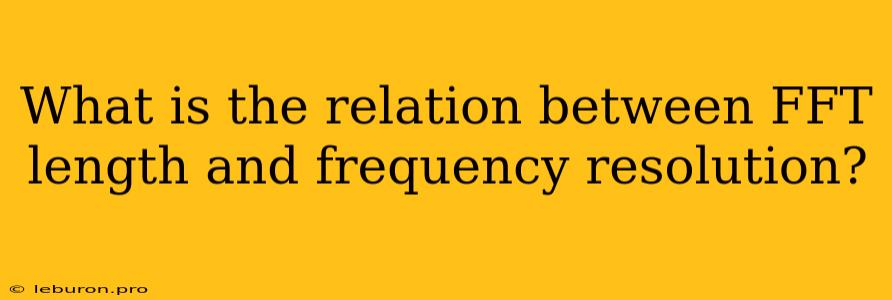The Fast Fourier Transform (FFT) is a powerful algorithm used to efficiently compute the Discrete Fourier Transform (DFT), which decomposes a signal into its constituent frequencies. A crucial aspect of using the FFT is understanding the relationship between the FFT length and the resulting frequency resolution. This article will explore this relationship in detail, explaining how the FFT length directly impacts the precision with which we can distinguish individual frequency components in a signal.
The Relationship Between FFT Length and Frequency Resolution
The FFT length, denoted by N, directly influences the frequency resolution of the spectrum. Specifically, the frequency resolution, Δf, is inversely proportional to the FFT length, N. This relationship can be expressed mathematically as:
Δf = fs / N
where:
- Δf is the frequency resolution in Hz
- fs is the sampling frequency of the signal in Hz
- N is the FFT length
This equation highlights the fundamental principle: a longer FFT length results in a finer frequency resolution, allowing us to differentiate between closely spaced frequency components.
Understanding the Concept
Imagine analyzing a signal with a sampling frequency of 1000 Hz. If we use an FFT length of 1024, the frequency resolution will be 1000 Hz / 1024 ≈ 0.977 Hz. This means that the FFT will be able to distinguish between two frequency components that are at least 0.977 Hz apart.
However, if we increase the FFT length to 4096, the frequency resolution improves to 1000 Hz / 4096 ≈ 0.244 Hz. Now, we can differentiate between frequency components that are only 0.244 Hz apart.
Practical Implications
The relationship between FFT length and frequency resolution has several practical implications:
1. Choosing the Appropriate FFT Length
Selecting the right FFT length is essential for accurate spectral analysis. If we are analyzing a signal with closely spaced frequency components, we need a longer FFT length to ensure sufficient resolution. On the other hand, if the signal has widely spaced frequency components, a shorter FFT length might suffice.
2. Trade-offs
Increasing the FFT length improves frequency resolution but also comes with certain trade-offs:
- Computational cost: Longer FFTs require more computational resources and time.
- Memory usage: Longer FFTs require more memory to store the results.
- Frequency range: The maximum frequency that can be resolved is limited by the sampling frequency and the FFT length.
3. Windowing
Windowing techniques are often used to reduce spectral leakage, which can distort the frequency spectrum. The choice of window function and its parameters can also influence the effective frequency resolution.
Conclusion
The relationship between FFT length and frequency resolution is a fundamental concept in spectral analysis. By understanding this relationship, we can choose the appropriate FFT length to achieve the desired level of frequency resolution while considering the trade-offs involved. Remember that a longer FFT length generally provides a finer frequency resolution but comes with increased computational cost and memory usage. By carefully selecting the FFT length and considering other factors like windowing, we can obtain accurate and meaningful spectral information from our signals.
